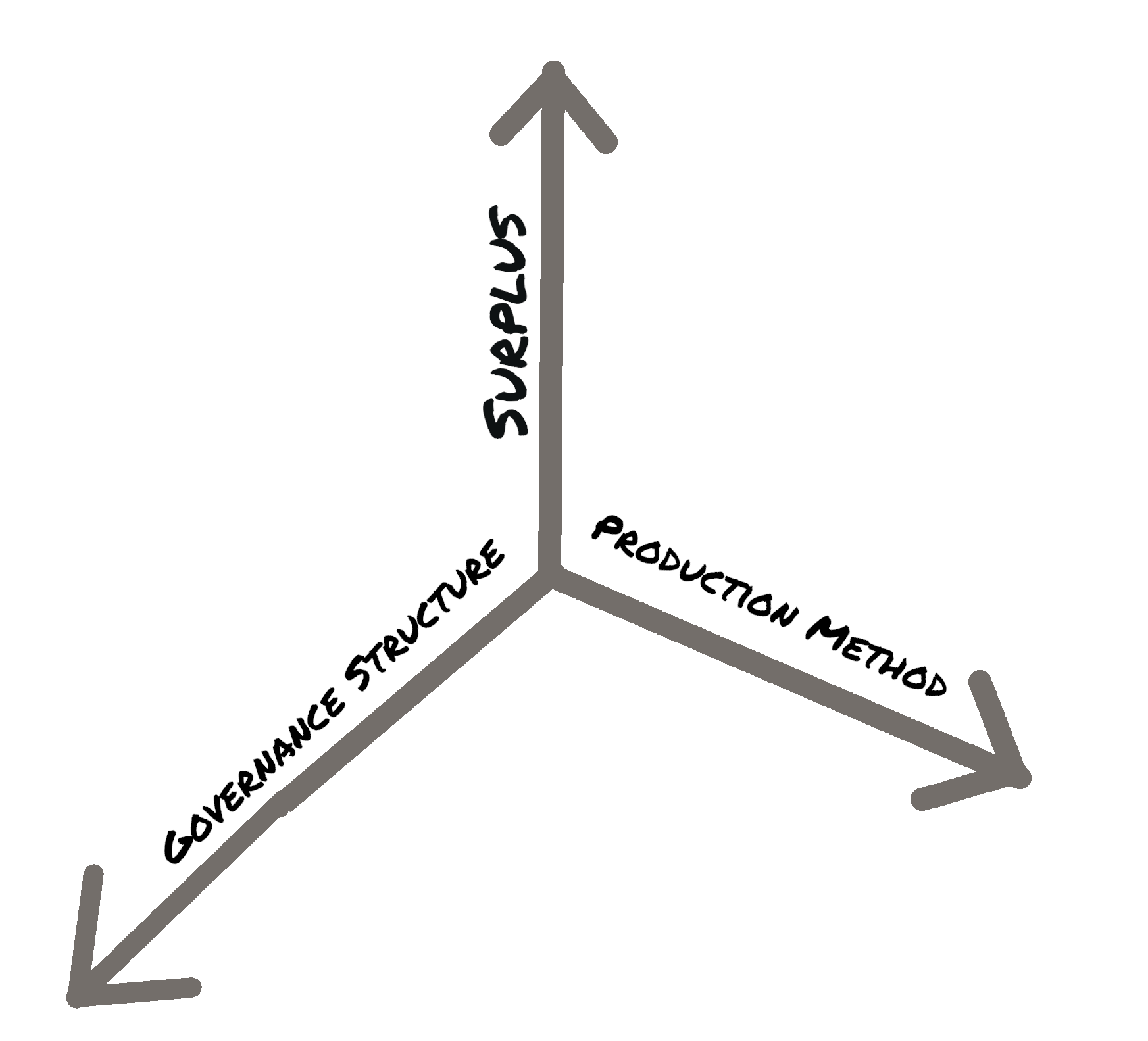
Using "Rugged Fitness Landscapes" to Think About Co-ops and Co-op Development
Rugged Fitness Landscapes

The image above is a “fitness landscape,” a visualization tool that originates in the field of evolutionary biology. Here’s Wikipedia’s description:
fitness landscapes or adaptive landscapes (types of evolutionary landscapes) are used to visualize the relationship between genotypes and reproductive success. It is assumed that every genotype has a well-defined replication rate (often referred to as fitness). This fitness is the "height" of the landscape. Genotypes which are similar are said to be "close" to each other, while those that are very different are "far" from each other. The set of all possible genotypes, their degree of similarity, and their related fitness values is then called a fitness landscape.
A genotype is just a particular genetic makeup – a specific combination of traits.
The fitness landscape above might represent, for example, the deer in my area. The horizontal X and Y axes might represent genes for reaction speed and attraction to bright lights respectively; the vertical Z axis, the reproductive success of individuals with each combination of characteristics. The blue areas would represent deer whose combination of reaction speed and attraction to lights gets them hit by a car before they have a chance to procreate. The red areas would be deer whose combination of speed and aversion to headlights help them live long and produce lots of offspring. Species’ genotypes, therefore, tend to cluster around “peaks” in the fitness landscape. This is, of course, a drastic simplification of both reality and the model, but hopefully you get the idea. This video does a good job of explaining the concept in more detail, if it’s still a little fuzzy for you.
Now imagine that this fitness landscape is not a representation of the types of deer that will thrive in rural Montana, but rather a depiction of worker co-ops (or potential worker co-ops) and the amount of surplus they can realize (using surplus as a proxy for success). In this case, the three axes of the fitness landscape above might look something like this:

So now the X and Y axes on our fitness landscape represent different combinations of production methods and governance structure, for businesses creating a particular product in a particular market. The “production method” axis might represent more or less division of labor in the production process, while the “governance structure” axis might delineate degrees of decentralization in the decision making apparatus of a co-op. The Z axis could represent total surplus, surplus per member, patronage dividends, or some other similar measure of overall success.
There are, of course, many more than two characteristics that lead to the success (or otherwise) of a business enterprise, just as there are more things that effect the reproductive success of my neighborhood deer than reflexes and attraction to bright lights. However, by starting with this simplified model and exploring some of its implications, I think we can gain some insight into useful heuristics (“rules-of-thumb”) for developing cooperatives in a rugged — and largely uncharted — fitness landscape.
Rules for Climbing Mountains
An individual cooperative finds itself in the following position: 1) it occupies a particular location in a rugged fitness landscape; 2) wanting to reach a higher elevation, if possible; but 3) lacking a good map; and 4) being only fully aware of the ground upon which it stands, so to speak.
The co-op as an entity may have some vague and fuzzy sense of the contours of the fitness landscape around it, but the only way they can know for sure if moving in one direction or another will lead them to a higher elevation on the landscape is to actually move there and find out (i.e. adjust production methods or governance structure in some way and see if it leads to greater surplus than what is currently being done). However, 5) moving to a new location on the landscape is itself a costly proposition, in terms of both money and increased risk, as there is a distinct possibility of arriving at a lower — rather than a higher — elevation, given the unknown nature of the surrounding contours. And, of course, if that does turn out to be the case, the co-op will have to expend additional resources to return to its previous location.
The high degree of uncertainty and costly nature of moving, combined with the extremely undesirable consequences of blundering from a sustainable location on the landscape into an unsustainable one (i.e. the failure of the co-op), come together to suggest our first heuristic: take baby steps, especially if your current location is sustainable. If what you are doing presently is working sustainably, try small adjustments over large ones, and have a preference for changes that are low-cost and easily reversible.
Contrariwise, if the location where your co-op currently finds itself happens to be unsustainable — i.e. unable to provide enough in wages and surplus distributions to make the enterprise worth people’s time to maintain — then big steps may well be called for. But as we’ve mentioned, moving from one way of doing things to another is risky, and ideally we want to minimize risk, as livelihoods are at stake if the gamble doesn’t pay off. This leads us to our second heuristic for climbing mountains in a rugged fitness landscape: if where you’re at isn’t working, move to a place that others have already shown to be sustainable.
And, of course, starting in a sustainable place is preferable to moving to one. It takes a lot of commitment and sacrifice to start a worker cooperative, or any other type of co-op, and some people bear much more of the sacrifice than others. The worker-owners of a startup co-op must often commit to working essentially for free for 1 - 3 years, until the business is stabilized — not only risking their savings to start the business, but also forgoing to ability to be working in the private sector during that time and getting paid (at least in theory) for every hour. The costs of starting a worker co-op, even in the best of circumstances, are substantial. So when embarking on such an endeavor, it would seem wise to start out pretty close to an existing co-op, where the height of the landscape is already known.
In business, as in life, nothing is certain — but still, if a particular way of doing things is working for one co-op, we would expect the odds of that same thing working for another co-op to be higher than them trying something entirely new, that no one has ever done before. In my personal experience of assisting a worker co-op startup, figuring out a business model that can sustain itself and its members from scratch is a difficult and an expensive endeavor...and one that is best avoided if at all possible — unless, of course, you can afford to work unpaid for years on end. Some people can, but the majority of us wanting to start co-ops cannot. By starting co-ops that “look” a lot like existing, sustainable cooperatives, we decrease the chances of that happening.
Contrariwise, attempting to set up shop in a completely unknown area of the landscape is a highly risky endeavor, which should probably be avoided by those who don’t have money to lose. If successfully replicating a co-op that has already proven successful is the equivalent of needing to just not roll a 1 on a dice toss, then starting up an enterprise in an unknown area of the fitness landscape is like needing to roll a 6 to avoid losing your stake. I’d be willing to put a little money down on the first wager, but nothing at all on the second.
Which isn’t to say that no one should ever take the second wager. Maybe your co-op does roll a 6, so to speak, and discovers a previously unknown peak in the fitness landscape. If that turns out to be the case, the wager pays off not just for the people who took the initial gamble, but for everyone else who now has more information about the contours of their shared fitness landscape. There are good reasons why we, as a movement, might want some group among us to take a gamble with a high risk-high reward payoff.
But we should be clear about the amount of risk involved in starting different types of enterprises, and not conflate results from co-ops who have been successful at relatively low-risk endeavors in well known terrain (e.g. the Arizmendi Association bakery co-ops), with the likely results of co-op projects that have high levels of inherent risk, simply by dint of trying something that hasn’t been done before.
I take from this two additional heuristics: be clear about the risk levels involved in an effort, based on our best knowledge of past and present experiences; and don’t encourage high-risk endeavors by groups who can’t afford to lose their investment of time and money. Another way to put that may be, ensure that financial and non-financial risk are distributed to those best positioned to handle a loss. On a practical level this means (among other things) that if a co-op project does run into difficulties (which is inevitable) and losses have to be distributed (which is close to inevitable), make sure those losses get meted out to those at the top of the income scale first.
Taking all these together as guidelines for action suggests to me that something along the lines of a franchise model would be a pragmatic way of increasing the number of co-ops generally, and worker co-ops in particular. This doesn’t mean that we should emulate the unethical or uncooperative aspects of the capitalist franchise model, but there is a reason, after all, that McDonald’s is a ubiquitous presence in our communities. What we can learn from them is to replicate that which has already been successful, and explore and adapt the landscape (i.e. make adjustments to the business) from there, rather than focusing on the next big, unproven idea, hoping that it will work out as intended.
Most people who want to enter the worker co-op world as worker-owners (as opposed to salaried developers or technical assistance providers), can not afford to invest their savings and years of their lives into a business without good reasons to believe that their investment will yield returns in the relatively near term. A cooperative version of a franchise model, like what the Arizmendi Association has been doing for decades in the Bay Area, is one way to meet that need. That way, when we are out in the world, spreading the worker co-op gospel, we can say to prospective worker-owners, “Yes, starting a new worker co-op is taking a risk, but this particular risk is one that we know a lot about, and can help guide you through. The payoff is worth it, and the risks have been minimized in advance.”...and also, “you can expect to get a respectable paycheck out of this within months, not years.” That part is more important than we tend to give it credit for.
Requirements of a Good Map
Now maps, of course, are abstractions that we use to inform our actions in the world, to attempt to get from point A to point B. No map can ever be a 1-to-1 recreation of the reality it seeks to describe, but sometimes having an incomplete map — one that is missing necessary or relevant information — can be worse than having no map at all.
A map that shows only the peaks in a landscape is of limited usefulness, and yet those are the parts of the landscape we are most likely to be able to map, due to simple survivorship bias. That is, we tend to hear a lot more about the things that have worked than we do about the things that haven’t. And we are more likely to hear from those for whom a particular strategy worked, than from those for whom the strategy failed. Worker-owners and developers are not generally asked to speak about their failures and abortive efforts at conferences, for instance, and failed co-ops (or attempted co-ops) are much more likely to miss the notice of people gathering statistics on such things than co-ops that succeed.
Failing to remedy this natural bias means that our map of the fitness landscapes we exist within will always be lacking in important information. We need to know where the valleys are, as well as the peaks. We need to know if deviations in one direction or another from a sustainable location have led to the discovery of any unexpected cliffs. And we need to know about the path co-ops have taken, when they have moved from an unsustainable valley to a sustainable peak. If we only get information about the peak, in these cases, and not the landscape traversed on the way there, those attempting to follow behind will be operating with only half of the necessary information, and will risk falling prey to the same hazards and obstacles as the previous effort, unnecessarily increasing the risk of failure. Which is all just a long way of saying we need to do better at learning from our mistakes.
And, of course, in order to learn from our mistakes, we need to be willing to admit them, and discuss them openly, regardless of anxieties about bad PR for the movement. Trust me, a co-op and its members falling into a crevasse and breaking their metaphorical necks because we provided them with a faulty map* is even worse PR.
What I’d like to see is a much deeper, and much more thorough, sharing of information between cooperatives, with an eye specifically to enabling replication of successful cooperative businesses, and to helping new cooperative projects avoid what should be well-marked pitfalls and hazards.
And while I’ve been discussing the use of fitness landscapes in relation to individual co-ops, I think there is also scope for applying this intellectual tool to the cooperative landscape on a regional, national, and global scale. The world is full of cooperative peaks, islands of hope in an unforgiving fitness landscape that’s more rugged than the Mission Mountains watching over me as I write this. It is our duty as cooperative practitioners, researchers, and advocates, to identify those peaks and to chart the surrounding terrain, so that they may be expanded and populated by as many of our beloved cooperators as possible.
*to extend this metaphor to its breaking point.
Citations
Josh Davis (2021). The Landscape of Co-op Development: Using "Rugged Fitness Landscapes" to Think About Co-ops and Co-op Development. Grassroots Economic Organizing (GEO). https://geo.coop/articles/landscape-co-op-development

Comments
Kate Whittle
September 8, 2021, 5:08 am
Absolutely agree about being upfront about our mistakes. Making mistakes is a vital part of the learning process, we shouldn't be afraid or ashamed of them.
Add new comment